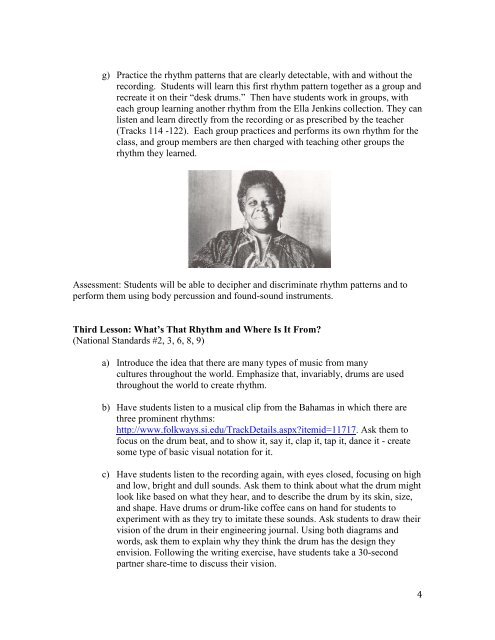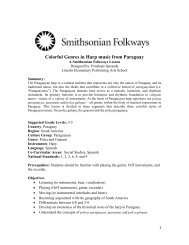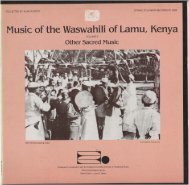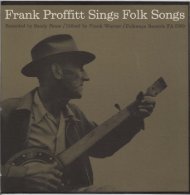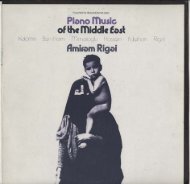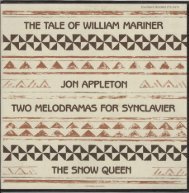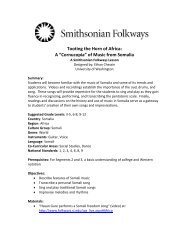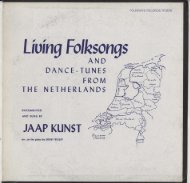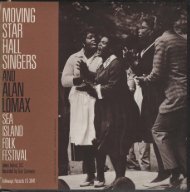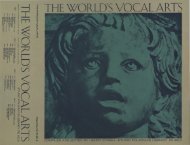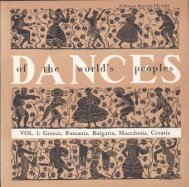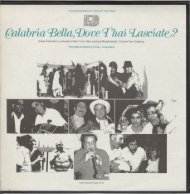Beats, Rhythms, and Drums: Grooves of the World
Beats, Rhythms, and Drums: Grooves of the World
Beats, Rhythms, and Drums: Grooves of the World
Create successful ePaper yourself
Turn your PDF publications into a flip-book with our unique Google optimized e-Paper software.
g) Practice <strong>the</strong> rhythm patterns that are clearly detectable, with <strong>and</strong> without <strong>the</strong><br />
recording. Students will learn this first rhythm pattern toge<strong>the</strong>r as a group <strong>and</strong><br />
recreate it on <strong>the</strong>ir “desk drums.” Then have students work in groups, with<br />
each group learning ano<strong>the</strong>r rhythm from <strong>the</strong> Ella Jenkins collection. They can<br />
listen <strong>and</strong> learn directly from <strong>the</strong> recording or as prescribed by <strong>the</strong> teacher<br />
(Tracks 114 -122). Each group practices <strong>and</strong> performs its own rhythm for <strong>the</strong><br />
class, <strong>and</strong> group members are <strong>the</strong>n charged with teaching o<strong>the</strong>r groups <strong>the</strong><br />
rhythm <strong>the</strong>y learned.<br />
Assessment: Students will be able to decipher <strong>and</strong> discriminate rhythm patterns <strong>and</strong> to<br />
perform <strong>the</strong>m using body percussion <strong>and</strong> found-sound instruments.<br />
Third Lesson: What’s That Rhythm <strong>and</strong> Where Is It From?<br />
(National St<strong>and</strong>ards #2, 3, 6, 8, 9)<br />
a) Introduce <strong>the</strong> idea that <strong>the</strong>re are many types <strong>of</strong> music from many<br />
cultures throughout <strong>the</strong> world. Emphasize that, invariably, drums are used<br />
throughout <strong>the</strong> world to create rhythm.<br />
b) Have students listen to a musical clip from <strong>the</strong> Bahamas in which <strong>the</strong>re are<br />
three prominent rhythms:<br />
http://www.folkways.si.edu/TrackDetails.aspx?itemid=11717. Ask <strong>the</strong>m to<br />
focus on <strong>the</strong> drum beat, <strong>and</strong> to show it, say it, clap it, tap it, dance it - create<br />
some type <strong>of</strong> basic visual notation for it.<br />
c) Have students listen to <strong>the</strong> recording again, with eyes closed, focusing on high<br />
<strong>and</strong> low, bright <strong>and</strong> dull sounds. Ask <strong>the</strong>m to think about what <strong>the</strong> drum might<br />
look like based on what <strong>the</strong>y hear, <strong>and</strong> to describe <strong>the</strong> drum by its skin, size,<br />
<strong>and</strong> shape. Have drums or drum-like c<strong>of</strong>fee cans on h<strong>and</strong> for students to<br />
experiment with as <strong>the</strong>y try to imitate <strong>the</strong>se sounds. Ask students to draw <strong>the</strong>ir<br />
vision <strong>of</strong> <strong>the</strong> drum in <strong>the</strong>ir engineering journal. Using both diagrams <strong>and</strong><br />
words, ask <strong>the</strong>m to explain why <strong>the</strong>y think <strong>the</strong> drum has <strong>the</strong> design <strong>the</strong>y<br />
envision. Following <strong>the</strong> writing exercise, have students take a 30-second<br />
partner share-time to discuss <strong>the</strong>ir vision.<br />
4


